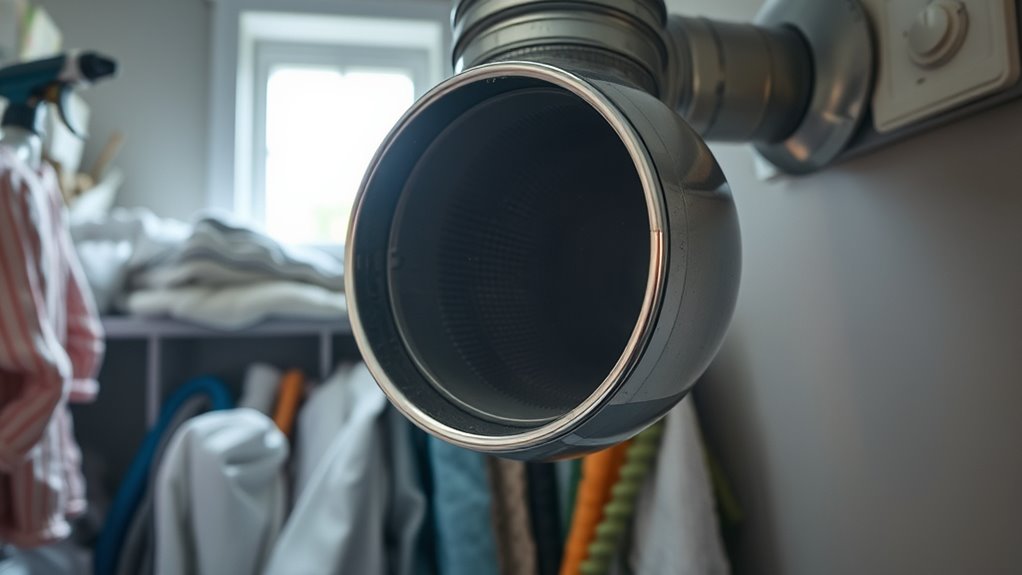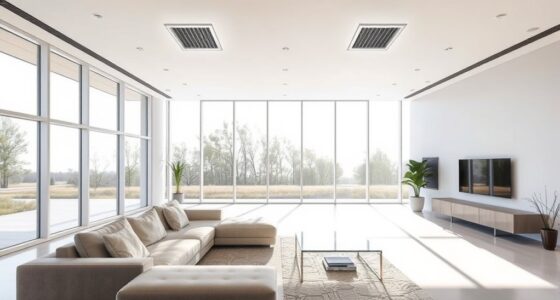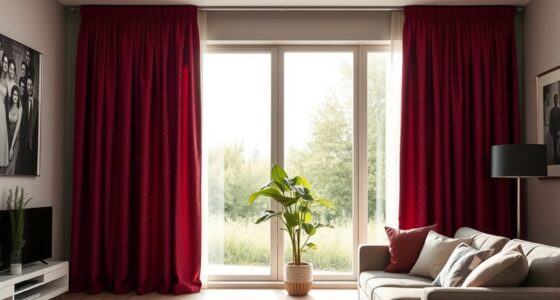Negative pressure at home happens when your indoor air becomes less than outside air, often because of venting mistakes like improper installation or blocked vents. This can cause outdoor pollutants, odors, or dangerous gases like carbon monoxide to backdraft into your home, affecting your air quality and safety. If you’re using exhaust fans or appliances haphazardly, you’re risking negative pressure build-up. Keep going to discover simple ways to fix and prevent these issues before they impact your home.
Key Takeaways
- Negative pressure occurs when indoor air is pulled outside, disrupting airflow and potentially drawing in pollutants or moisture.
- Improper venting or blocked ducts can cause negative pressure, leading to appliance malfunctions and poor indoor air quality.
- Correct vent installation, sealing leaks, and regular maintenance prevent negative pressure issues in homes.
- Simple adjustments like clearing obstructions or adding makeup air sources can restore proper airflow.
- Regular inspection and responsible ventilation practices help avoid the harmful effects of negative pressure at home.
Understanding Negative Pressure and Its Effects

Negative pressure occurs when the air pressure inside a space is lower than the outside air pressure, causing air to flow into that area. This imbalance affects air pressure dynamics, which are essential to understanding how your home ventilates. When negative pressure develops, it can pull in outdoor pollutants, unpleasant odors, or moisture, disrupting your indoor air quality. Ventilation fundamentals highlight the importance of balanced airflow to prevent such issues. If your home isn’t properly vented, negative pressure can cause appliances like exhaust fans or range hoods to malfunction or backdraft dangerous gases. Recognizing how air pressure differences work helps you maintain a safe, healthy environment. Proper ventilation ensures that negative pressure doesn’t compromise your home’s safety or comfort.
Common Appliances That Contribute to Venting Issues
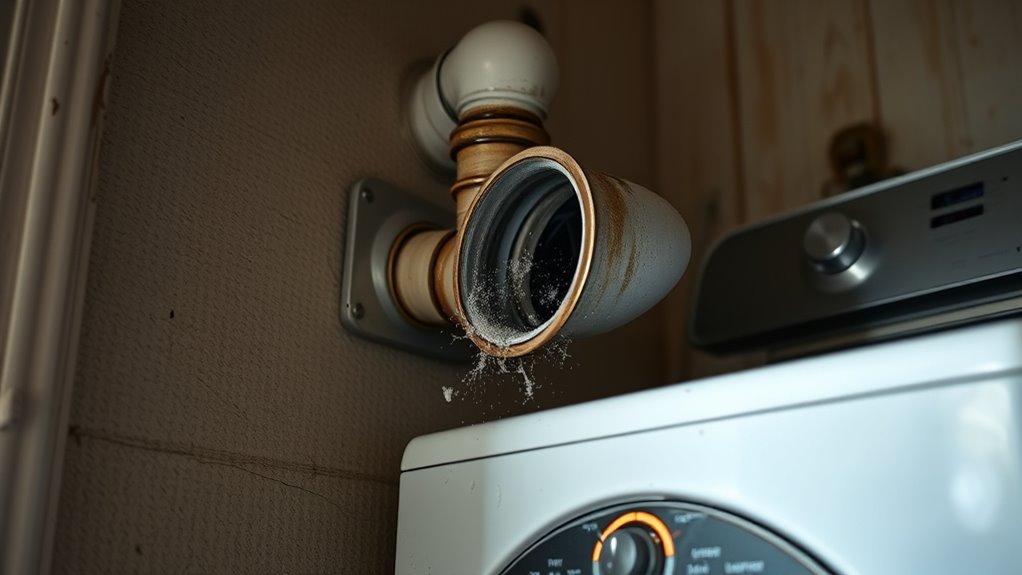
Certain household appliances can substantially impact your home’s ventilation by creating negative pressure, especially if they aren’t properly vented. Appliances like kitchen exhaust fans, clothes dryers, and gas water heaters often contribute to venting issues when they malfunction or aren’t installed according to venting regulations. An appliance malfunction, such as a blocked vent or damaged duct, can reduce airflow, causing negative pressure inside your home. This imbalance can pull in outdoor air through gaps, leading to poor indoor air quality and potential hazards. Ensuring these appliances are correctly vented and maintained is essential. Failing to follow venting regulations increases the risk of improper venting, which can exacerbate negative pressure problems and compromise your home’s safety and comfort. Additionally, understanding venting best practices is crucial for maintaining proper airflow and preventing these issues.
How Improper Venting Can Lead to Indoor Air Quality Problems

When appliances aren’t properly vented, they can considerably compromise your home’s indoor air quality. A faulty venting system allows indoor moisture and pollutants to accumulate, creating a damp environment that encourages mold growth and dust mites. Poor ventilation can also cause dangerous fumes, like carbon monoxide, to linger inside your living space. When moisture isn’t vented outside effectively, it increases humidity levels, leading to condensation on walls and ceilings, which worsens indoor air quality. These issues can trigger allergies, respiratory problems, and other health concerns. Ensuring your venting system works properly helps remove excess moisture and pollutants, maintaining a healthier indoor environment. Proper venting is essential to prevent indoor air quality problems linked to improper appliance venting and to support self watering plant pots, which require proper moisture management.
The Role of Exhaust Fans and Their Placement Mistakes
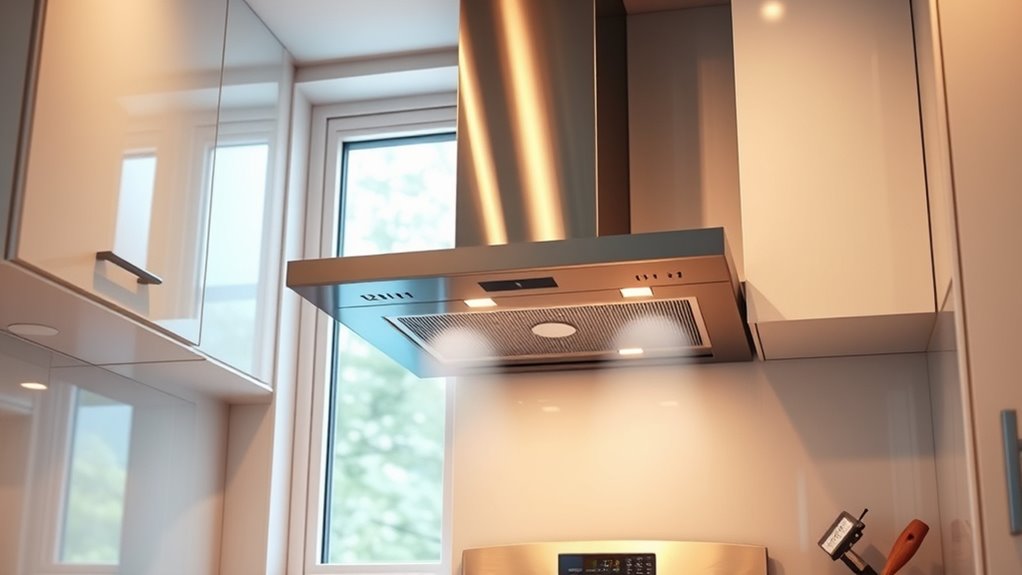
Proper placement of exhaust fans plays a vital role in maintaining good indoor air quality. When you install an exhaust fan, think carefully about its location to guarantee it effectively removes indoor pollutants without causing negative pressure. Incorrect exhaust fan placement can draw in unconditioned or contaminated air from outside or other areas, worsening air quality. A well-designed venting system considers the fan’s position relative to moisture sources like bathrooms and kitchens, avoiding venting into attics or crawl spaces. Poor venting system design can lead to inefficient airflow and increased negative pressure, pulling in pollutants or dangerous gases. To prevent these issues, position your exhaust fans where they can vent directly outside, ensuring proper airflow and maintaining a healthy indoor environment. Additionally, understanding ventilation principles can help optimize your system’s effectiveness and prevent unintended air infiltration.
Signs Your Home Is Suffering From Negative Pressure
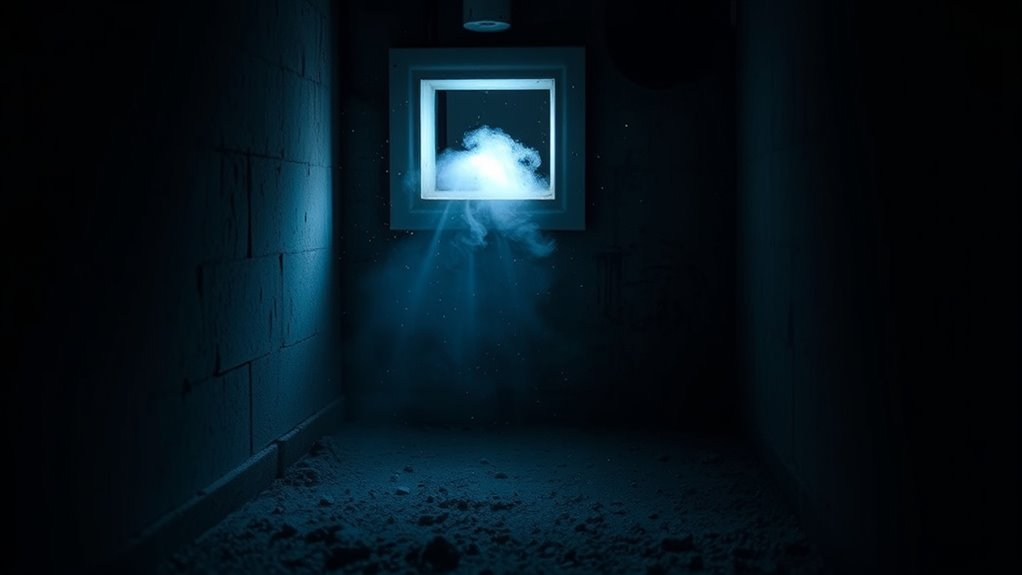
If your indoor air quality suddenly worsens or feels stale, your home might be experiencing negative pressure. You may also notice your energy bills climbing higher than usual. These signs indicate that proper ventilation could be lacking, allowing outside air to influence your home’s environment. Using the wrong type of ventilation system can exacerbate this issue, leading to further air imbalance.
Unusual Indoor Air Quality
Unusual indoor air quality often signals that your home might be experiencing negative pressure. You may notice persistent stuffiness, odors, or allergies that don’t clear with air filtration. Poor humidity control can also cause dampness or dry air, making the environment uncomfortable and affecting air quality. To visualize this, consider the table below:
| Signs of Negative Pressure | Possible Causes |
|---|---|
| Musty odors lingering | Exhaust fans pulling in outside air |
| Increased dust and allergens | Imbalanced humidity levels |
| Stale, stuffy air | Insufficient air filtration |
| Unexplained drafts | Improper venting or sealing issues |
These signs indicate your home’s air isn’t circulating properly, compromising air quality and comfort. Additionally, ventilation issues can exacerbate negative pressure, further deteriorating indoor air quality.
Increased Energy Costs
You may notice your energy bills climbing higher than usual when your home suffers from negative pressure. This issue forces your HVAC system to work harder to maintain a comfortable temperature, reducing its efficiency. As your HVAC struggles to compensate, your energy consumption increases, leading to higher costs. Negative pressure can also cause appliances like your water heater or furnace to operate inefficiently or improperly vent, further raising energy use. Regular appliance maintenance becomes even more critical to ensure these systems run smoothly despite the pressure imbalance. Additionally, sealing leaks and improving ventilation can help restore proper airflow, allowing your HVAC system to operate at its best. Understanding relationships – personality traits can help in addressing underlying emotional issues that may contribute to home stress and pressure. Addressing negative pressure not only saves money but also extends the lifespan of your appliances and enhances overall home comfort.
Mistakes to Avoid When Installing Venting Systems

Installing venting systems without careful planning can lead to serious issues, including decreased efficiency and safety hazards. One common mistake is choosing improper venting materials that aren’t rated for your system’s temperature and pressure. Always follow installation guidelines provided by manufacturers to guarantee proper airflow and safety. Avoid shortcuts like skipping necessary sealing or insulation steps, which can cause leaks or condensation problems. Improperly installed vents may also create blockages or improper slopes, hindering proper exhaust flow. Before starting, verify that your venting materials meet local building codes and manufacturer recommendations. Neglecting these details can result in dangerous backdrafts, carbon monoxide buildup, or system failure. Proper venting system installation is essential to prevent these hazards and ensure safe operation. Careful adherence to installation guidelines and proper material selection are vital for a safe, efficient venting system.
Simple Fixes to Correct Venting and Restore Balance
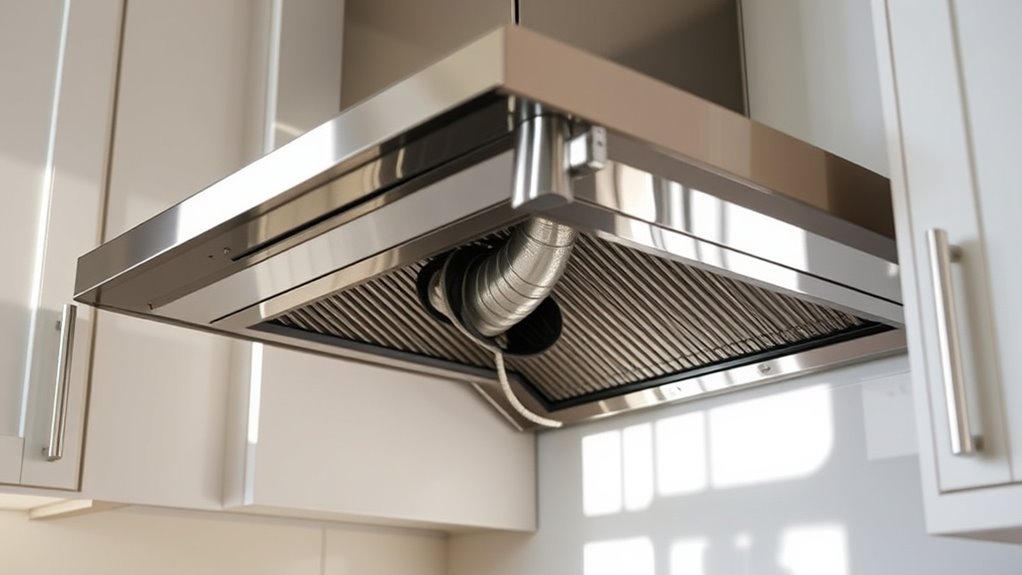
When venting systems become unbalanced, simple adjustments can often restore proper airflow and improve overall safety. First, clear any obstructions around vents and exhaust outlets to ensure unobstructed airflow. Many venting myths suggest complex fixes, but understanding airflow basics reveals that proper vent placement and sizing are key. Check that vents are correctly connected and not blocked or leaking. You might also consider installing additional vents or adjusting existing ones to balance pressure. Ensuring exhaust fans operate efficiently without creating negative pressure is essential. Small tweaks, like sealing leaks or adding makeup air sources, can make a big difference. Additionally, being aware of negative pressure effects helps you identify simple fixes that prevent dangerous negative pressure and keep your home safe. Remember, understanding airflow basics helps you identify simple fixes that prevent dangerous negative pressure and keep your home safe.
Preventative Tips for Maintaining Proper Home Ventilation
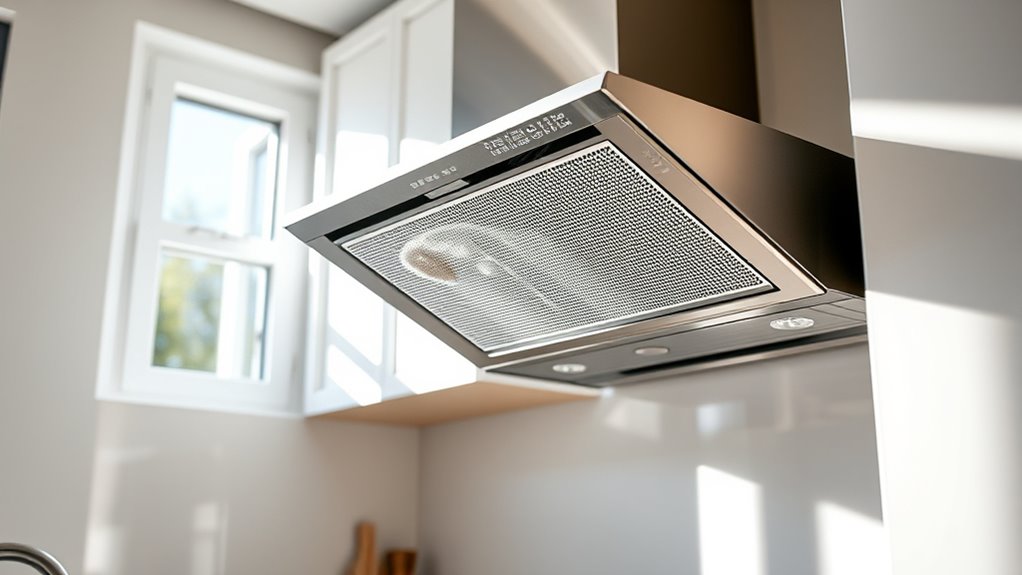
Regularly inspecting and maintaining your home’s ventilation system can prevent issues before they start. Keep your air purifier in top shape by replacing filters as recommended, ensuring it continues to improve indoor air quality effectively. Proper air purifier maintenance helps reduce airborne pollutants that can worsen negative pressure problems. Additionally, use window sealing techniques to prevent air leaks that cause pressure imbalances. Seal gaps around windows and doors with weatherstripping or caulking to maintain controlled airflow. Ventilation systems should be checked periodically for blockages or malfunctions. Using responsible wood fuel can also help reduce indoor pollutants associated with heating systems. By combining routine air purifier upkeep with effective window sealing, you create a balanced environment that minimizes negative pressure, improves air quality, and reduces the risk of venting mistakes. Prevention is key to a healthier, properly ventilated home.
Frequently Asked Questions
Can Negative Pressure Cause Health Issues in My Home?
Yes, negative pressure can cause health issues in your home. When your indoor air quality drops due to poor ventilation strategies, you may draw in pollutants, allergens, or even carbon monoxide from outside. This can lead to headaches, dizziness, or respiratory problems. To prevent this, guarantee proper ventilation and avoid creating negative pressure, which helps maintain fresh air flow and keeps your indoor environment healthy and safe.
How Can I Test if My Home Has Negative Pressure?
You can test your home’s air pressure by using simple testing methods like holding a lit incense stick or a tissue near gaps around doors and windows. If the smoke or tissue moves inward, your home likely has negative pressure. Alternatively, a manometer can give precise measurements. Regularly testing helps identify negative pressure, so you can address venting issues and improve indoor air quality.
Are There Specific Appliances More Prone to Causing Negative Pressure?
Bathroom fans and appliance exhaust systems are more prone to causing negative pressure in your home. While they remove moisture and odors, they can draw in outside air if not properly vented, creating a vacuum that pulls in unfiltered air. This imbalance can lead to issues like backdrafting of harmful gases. To prevent this, guarantee all exhaust systems are correctly installed and regularly maintained, balancing airflow and safeguarding your indoor air quality.
What Are the Long-Term Effects of Ongoing Negative Pressure?
Ongoing negative pressure can lead to a ventilation imbalance, causing your home to feel stuffy and reduce indoor air quality. Over time, this imbalance puts structural stress on your walls and foundation, potentially leading to cracks or other damage. It also increases the risk of backdrafting harmful gases like carbon monoxide, posing health hazards. Addressing venting issues promptly helps maintain a balanced, safe, and structurally sound home environment.
Is Negative Pressure More Common in New or Older Homes?
Like a well-aged wine, older homes often have less efficient ventilation systems, making negative pressure more common. You’ll find this issue more in older buildings with outdated venting setups that don’t properly balance air flow. Newer homes typically have modern ventilation systems designed to prevent negative pressure, though mistakes still happen. So, if your home’s age leans toward the vintage side, watch out for signs of venting problems.
Conclusion
When you overlook proper venting, it’s easy for negative pressure to quietly take hold, turning your home into an unintended trap for indoor pollutants. Imagine opening a window on a breezy day and realizing it’s just enough to restore fresh air—sometimes, a simple fix or mindful placement of your appliances can make all the difference. By staying attentive and proactive, you create a healthier, more comfortable space where fresh air naturally flows, and problems stay at bay.
